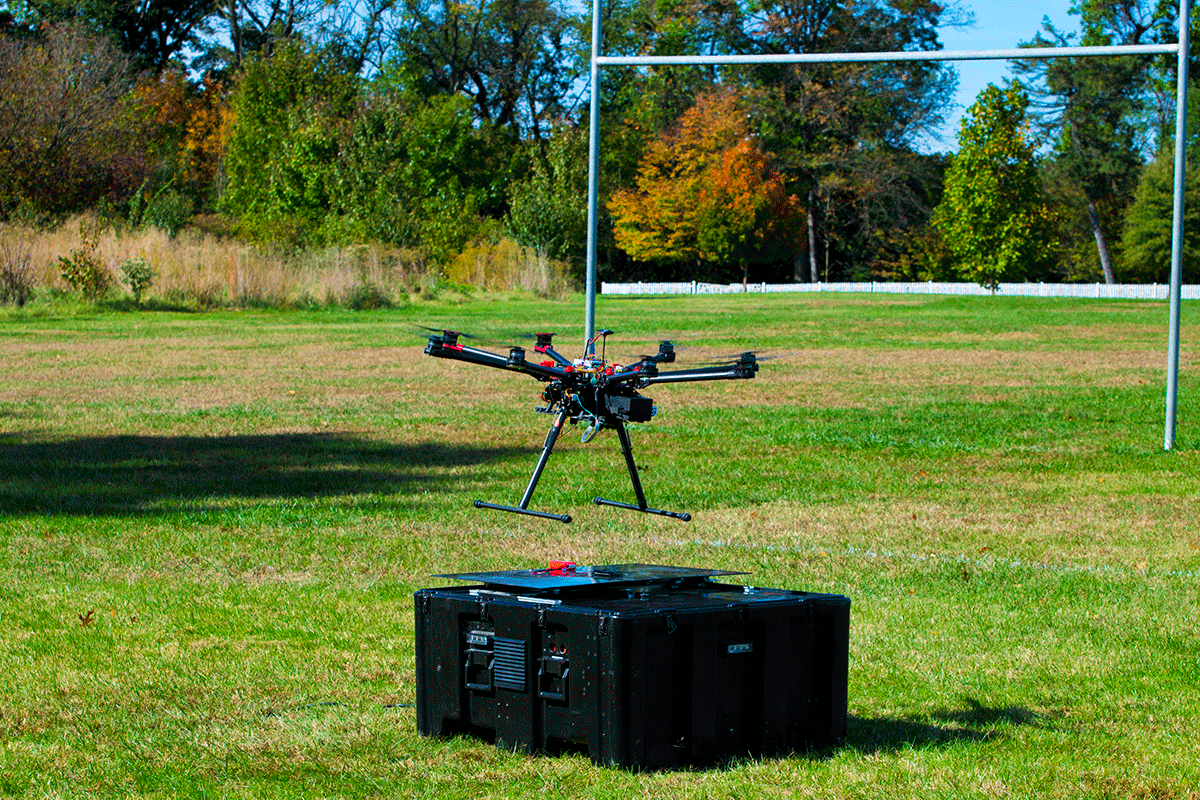For the past four or five years a vast number of innovative UAV models have entered the market. Countless new manufacturer startups are sprouting practically everyday and all over the world. The industry is experiencing a thrilling time in terms of new applications, clarity in regulations and a slow but steady insertion into our daily lives.
One conservative estimate is that the UAV industry will create 100,000 jobs and add $82B to the economy over the next ten years. Unfortunately, one single item on our list of key technologies to make this forecast feasible has been stubbornly constant and that is Time in the Air or the number of hours that a UAV can stay in flight.This item is of particular interest when it comes to covering large areas in mapping applications, infrastructure monitoring or traveling long distances when delivering packages or medicines. Battery manufacturers are struggling to come up with power to weight ratios greater than what we currently have and there’s no easy solution in sight. Thankfully, a new breed of entrepreneurs is coming forth with solutions to work around this limitation.At the Commercial UAV Expo in Las Vegas we had the opportunity to speak with representatives of some of these companies and explore their solutions to the conundrum of flying time. ASYLON (www.flyasylon.com) We met with Damon Henry, CEO of Asylon to inquire about their product DroneHome which allows UAV platforms to stay in the air for indefinite amounts of time using by exchanging batteries in the middle of the mission and returning the vehicle to the air in a short amount of time.The concept is a simple one. DroneHome is an intelligent station that contains 12 spare batteries and synchronizes with the UAV platform to exchange them at a pre-determined time. This allows for continuous flight times with brief interruptions for the exchange.“By providing a fixed or mobile automated battery-exchanging platform we are offering the industry an alternative to the 25 minutes flying time offered by most multi-rotor manufacturers,” said Damon.The DroneHome can be deployed in the field away from any power source for 12 battery exchanges or connected to the grid for unlimited flying time.This solution is particularly flexible when mounted in an automated vehicle that can follow the progress of the UAV platform as in power line inspections providing hours of flight time.
ASYLON (www.flyasylon.com) We met with Damon Henry, CEO of Asylon to inquire about their product DroneHome which allows UAV platforms to stay in the air for indefinite amounts of time using by exchanging batteries in the middle of the mission and returning the vehicle to the air in a short amount of time.The concept is a simple one. DroneHome is an intelligent station that contains 12 spare batteries and synchronizes with the UAV platform to exchange them at a pre-determined time. This allows for continuous flight times with brief interruptions for the exchange.“By providing a fixed or mobile automated battery-exchanging platform we are offering the industry an alternative to the 25 minutes flying time offered by most multi-rotor manufacturers,” said Damon.The DroneHome can be deployed in the field away from any power source for 12 battery exchanges or connected to the grid for unlimited flying time.This solution is particularly flexible when mounted in an automated vehicle that can follow the progress of the UAV platform as in power line inspections providing hours of flight time.  AeroVironment (www.avinc.com)Aerovironment is a leading supplier of UAVs for the military and commercial spaces. One of their most successful platforms, the Puma AE, has a large wingspan ideal for the installation of solar panels. Recently, they have teamed up with Alta Devices (www.altadevices.com) to retrofit a Puma AE with solar cells distributed throughout the wing span.According to Alta Devices, the AnyLighttm technology provides the UAV platform 5 times more daytime endurance at one gram per watt of power generated with virtually no impact on aerodynamics. Two important aspects of this solar alternative when compared to conventional battery power are the Power to Weight Ratio (Pm) and the Power to Area Ratio (Pa). The former defines the impact that the solar panels have on the aerodynamic characteristics of the UAV platform by adding weight and the latter is a direct correlation between the area occupied by the solar panels and the power generated by said area.Pa is particularly important due to the fact that some technologies offer high power-to-weight ratios but might suffer from low conversion rates, thus not allowing the UAV platform to obtain the full benefit of the technology when area is limited.Given restrictions in Pa solar cells are a great solution for fixed wing UAV with large wing areas and less ideal for small multi-rotors.
AeroVironment (www.avinc.com)Aerovironment is a leading supplier of UAVs for the military and commercial spaces. One of their most successful platforms, the Puma AE, has a large wingspan ideal for the installation of solar panels. Recently, they have teamed up with Alta Devices (www.altadevices.com) to retrofit a Puma AE with solar cells distributed throughout the wing span.According to Alta Devices, the AnyLighttm technology provides the UAV platform 5 times more daytime endurance at one gram per watt of power generated with virtually no impact on aerodynamics. Two important aspects of this solar alternative when compared to conventional battery power are the Power to Weight Ratio (Pm) and the Power to Area Ratio (Pa). The former defines the impact that the solar panels have on the aerodynamic characteristics of the UAV platform by adding weight and the latter is a direct correlation between the area occupied by the solar panels and the power generated by said area.Pa is particularly important due to the fact that some technologies offer high power-to-weight ratios but might suffer from low conversion rates, thus not allowing the UAV platform to obtain the full benefit of the technology when area is limited.Given restrictions in Pa solar cells are a great solution for fixed wing UAV with large wing areas and less ideal for small multi-rotors.  CyPhy Works (www.cyphyworks.com)Surprisingly, CyPhy Works was not present at the Commercial UAV Expo this year, but their tethered solution represents the best example of a company developing an in-house technology to overcome the battery life restriction. Their patented solution is termed CyPhy Works and uses a microfilament capable of transmitting high definition video, power and control indefinitely to an aerial platform that can fly up to 10,000 ft. This platform today is called Persistent Aerial Reconnaissance and Communications (PARC).PARC was developed originally for military uses and to be deployed in areas where constant vigilance over the terrain is necessary and time in the air is the key to success. The real breakthrough is the microfilament technology which can withstand weather and poor conditions and still deliver uninterrupted communications and power to a drone located thousands of feet in the air. These three examples of workarounds by the UAV industry are just the tip of the iceberg in terms of innovation to lengthen time-in-the-air, but what about battery technology? During the Expo in Las Vegas I was approached by two scientists from Texas A&M University and they shared with me what they are doing with of battery technology.Gang Yang is an entrepreneur and research assistant and Choongho Yu is associate professor at the department of mechanical engineering at Texas A&M University in College Station, TX. Gang and Professor Yu are working on Li-S batteries that can deliver 2-4 times more energy than Li-Ion equivalents. Their research gives hope to an industry that is looking for rational alternatives to a battery technology that was developed decades ago and is holding back the deployment of newer and better applications.
CyPhy Works (www.cyphyworks.com)Surprisingly, CyPhy Works was not present at the Commercial UAV Expo this year, but their tethered solution represents the best example of a company developing an in-house technology to overcome the battery life restriction. Their patented solution is termed CyPhy Works and uses a microfilament capable of transmitting high definition video, power and control indefinitely to an aerial platform that can fly up to 10,000 ft. This platform today is called Persistent Aerial Reconnaissance and Communications (PARC).PARC was developed originally for military uses and to be deployed in areas where constant vigilance over the terrain is necessary and time in the air is the key to success. The real breakthrough is the microfilament technology which can withstand weather and poor conditions and still deliver uninterrupted communications and power to a drone located thousands of feet in the air. These three examples of workarounds by the UAV industry are just the tip of the iceberg in terms of innovation to lengthen time-in-the-air, but what about battery technology? During the Expo in Las Vegas I was approached by two scientists from Texas A&M University and they shared with me what they are doing with of battery technology.Gang Yang is an entrepreneur and research assistant and Choongho Yu is associate professor at the department of mechanical engineering at Texas A&M University in College Station, TX. Gang and Professor Yu are working on Li-S batteries that can deliver 2-4 times more energy than Li-Ion equivalents. Their research gives hope to an industry that is looking for rational alternatives to a battery technology that was developed decades ago and is holding back the deployment of newer and better applications. 














Comments